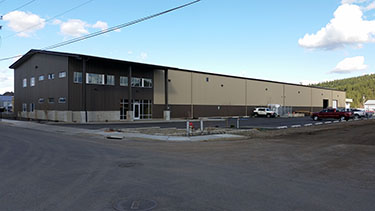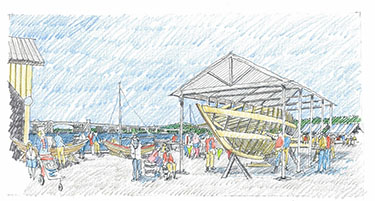|
Subscribe / Renew |
|
|
Contact Us |
|
| ► Subscribe to our Free Weekly Newsletter | |
| home | Welcome, sign in or click here to subscribe. | login |
Environment
| |
 |
September 29, 2016
Brownfields are becoming developers’ next frontier
Maul Foster & Alongi

Stringer |

Darling |
A row of empty mill buildings along a quiet river bank lined with old pilings. A sunbaked empty lot along a railroad track bordered by a chain link fence with the foundation of a former manufacturing plant barely visible beneath the weeds. These sites are symbols of the natural resource extraction economy’s decline.
Communities across Washington state are increasingly looking at vacant and shuttered former industrial sites as opportunities to spark revitalization.
From closed lumber mills in Aberdeen to a former rail yard in Spokane, local governments are following the examples of Tacoma’s Thea Foss Waterway and Bellingham’s Waterfront District by taking a leadership role in cleanup and redevelopment of brownfield properties. Through a combination of market forces, land-use planning and public-private partnerships, some of Washington’s most challenged properties are now becoming catalysts for redevelopment.
Redevelopment is the cure
Brownfield properties often sit vacant for years until a compelling future use is found that attracts financing and motivates parties to go through the cleanup process. With the real estate cycle’s current upswing, redevelopment is becoming the remedy to re-energize contaminated properties. As market demand continues to drive urban infill development, easier properties have been redeveloped and the next tier of more complex properties with legacy environmental impacts are now being addressed.
In the last two years, Washington’s Department of Ecology has seen a 50 percent increase in the number of contaminated sites being reported and increased applications into the Voluntary Cleanup Program.
In the hottest markets, like Seattle’s South Lake Union, the higher value of real estate can often bear the costs of environmental remediation. But in secondary markets, public sector investments are typically needed to mitigate clean-up costs and make redevelopment financially feasible. The costs and risks of environmental cleanup are often too large for the private sector to bear, and local governments are stepping in to significantly improve financial feasibility for projects.
Communities can capitalize on multiple state and federal funding and policy tools to achieve their economic goals. Examples from the east and west ends of the state show how local governments are strategically planning to position brownfield properties for adaptive re-use.
Hillyard
The Hillyard neighborhood in northeast Spokane was once the home of the Great Northern rail yard.
Developed by JJ Hill and known as “Hill’s Yard,” the rail yard once manufactured the country’s largest locomotive engines.
When the rail yard closed in the 1980s, the community lost hundreds of jobs. The surrounding area of approximately 500 acres of industrial-zoned property has slowly become the workbench of Spokane, housing dozens of small businesses including contractors, auto repair shops, fabricators, and food processors and distributors.
The long-awaited North Spokane Highway Corridor has reached the edge of the Hillyard industrial area, and with passage of the state Legislature’s latest transportation package, funding is in place to connect the highway to Interstate 90 and dramatically improve access and freight mobility to Hillyard.
The city of Spokane has established the Northeast Public Development Authority (NEPDA) to energize efforts to leverage this large infrastructure investment to create more jobs in this employment center. Real and perceived environmental contamination issues remain a challenge and need to be addressed to capitalize on this opportunity.
“The city is targeting our public resources to catalyze redevelopment in Hillyard,” says Teri Stripes, city of Spokane planner. “Through reaching out to private-sector partners and collaborating with the NEPDA, we have learned our most effective role is to get the right public infrastructure in place, package together financial incentives, and capitalize on state and federal resources to resolve environmental issues.”
The city has established Washington’s first Redevelopment Opportunity Zone. This new designation offers unique environmental risk-management tools and also prioritizes cleanup grant funding.
The city has obtained grants from the U.S. Environmental Protection Agency and state Department of Commerce to support these efforts.
Maul Foster & Alongi has teamed with EcoNorthwest and Heartland LLC to conduct a market assessment, evaluate financial feasibility of redevelopment projects, inventory potential brownfield properties, plan infrastructure improvements and develop strategies to promote revitalization.
These strategies will position the city to address critical concerns and attract private investment, enabling the Hillyard area to live up to its full potential as an employment center.
Seaport Landing
On the Washington coast, the city of Aberdeen is working with a public development authority to revitalize a former industrial area.
Aberdeen’s south waterfront on the Chehalis River was once home to a thriving mill complex and active commercial boatyard. The closure of both of these businesses in the last 10 years left approximately 30 acres of property and 2,000 feet of waterfront vacant.
The idea of creating a maritime heritage center has been discussed in the community since the 1980s when the city established the Grays Harbor Historical Seaport Authority (GHHSA). The public development authority has built and operates the Lady Washington tall ship and the Hawaiian Chieftain, but has not been able to complete the vision of a homeport for the ships.
Closure of the waterfront businesses created an opportunity for reuse of those properties to finally create that homeport. The city has contracted with Maul Foster & Alongi and a team of consultants to help make that vision a reality.
Approximately 5 million people per year drive through Aberdeen on their way to the Washington coast. The community is looking to encourage tourists to spend time and money in Aberdeen by designing a new gateway visitor center on Highway 12 at the city’s entrance. Across the river, GHHSA is transforming a former sawmill into a maritime heritage center.
Brandi Bednarik, GHHSA executive director explains, “The Seaport Landing project is an opportunity to unite education, public waterfront access and economic development. The property’s historic industrial use makes its environmental restoration and ultimate redevelopment even more significant.”
GHHSA plans to establish an environmental learning center on the property, a maritime training school, a woodworking shop to highlight wooden boat building and spar construction, a waterfront public access trail, and in-water moorage for the tall ships.
Maul Foster & Alongi is working with a multifaceted team including Harbor Architects, SRG Architects, Berger Partnership, Heartland LLC and BST Associates to develop strategies to fund and implement the property’s cleanup and its future redevelopment.
Jim Darling and Michael Stringer, AICP, lead Maul Foster & Alongi’s Seattle-based Brownfields Cleanup and Redevelopment Practice.
Other Stories:
- 3 things to consider about your building materials
- Survey: SoundEarth Strategies
- Survey: Coho Water Resources
- Survey: Landau Associates
- Survey: Shannon & Wilson
- Survey: Hart Crowser
- Still much to learn about the carbon story of buildings
- Robots go where no divers can to recover munitions
- With Passive House, incentives are all carrot and no stick
- New water plant saves Lynden from the ‘milkshake effect’
- Restoring an ecosystem? Get to know your geotech
- Reusing stormwater can release untapped benefits
- Navigating Washington’s water rights process
- Survey: Evergreen Certified





